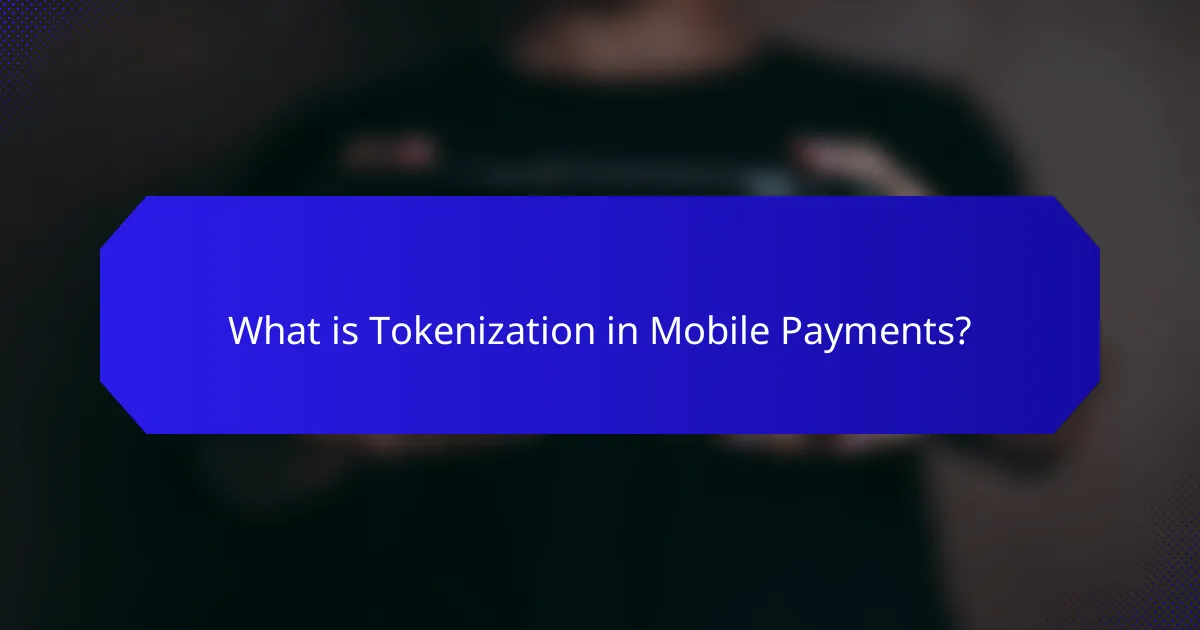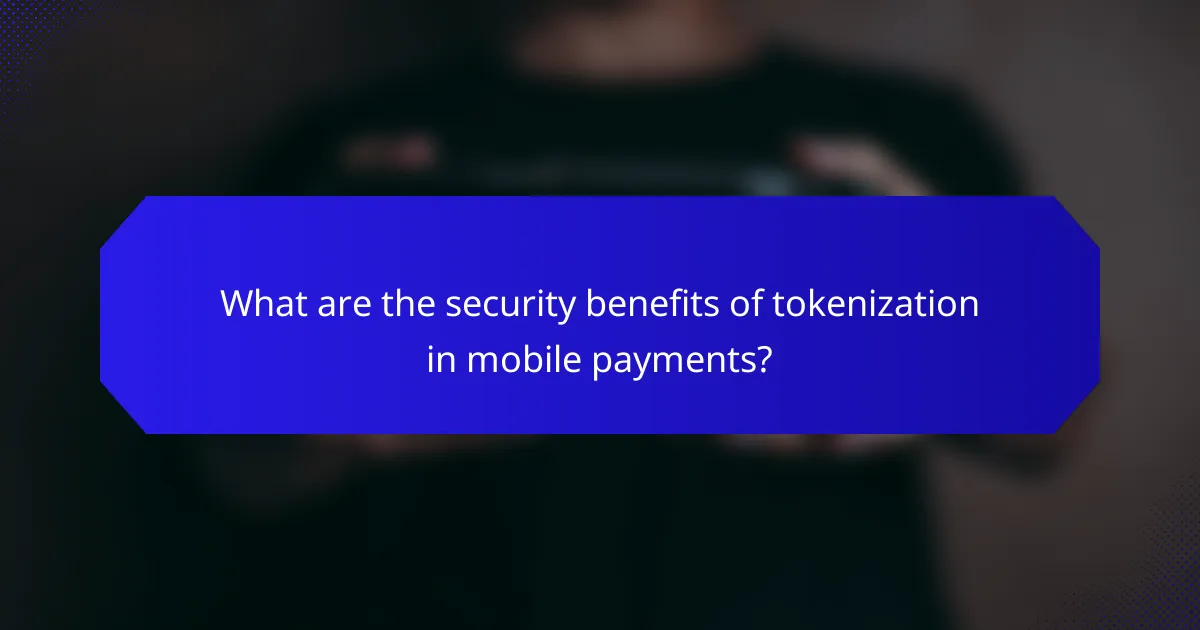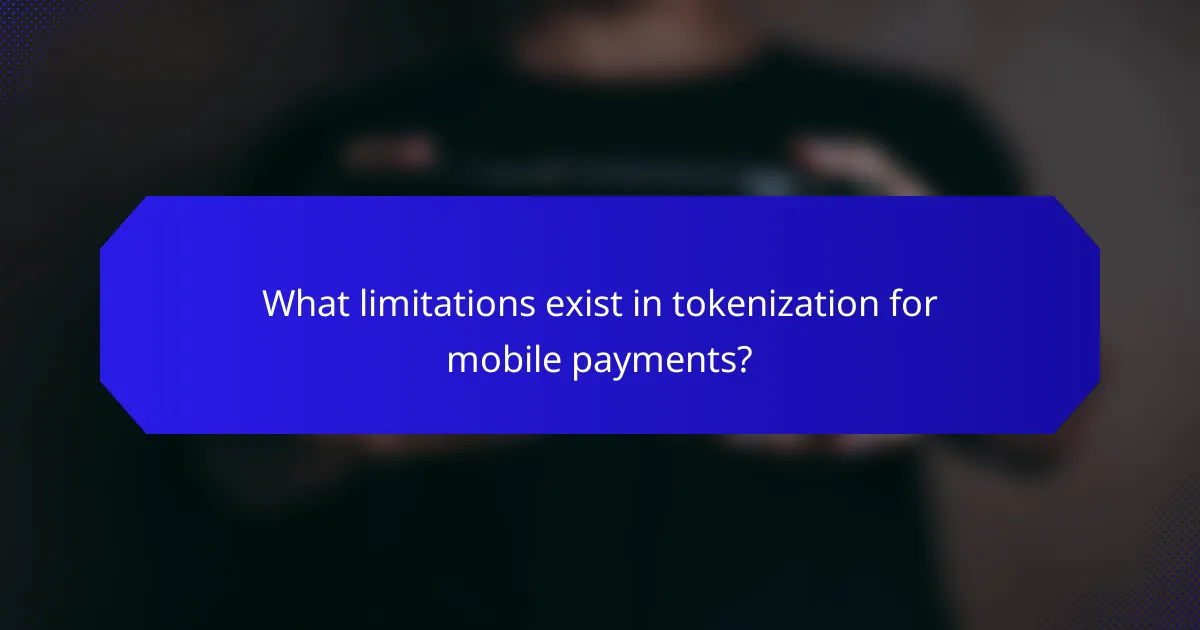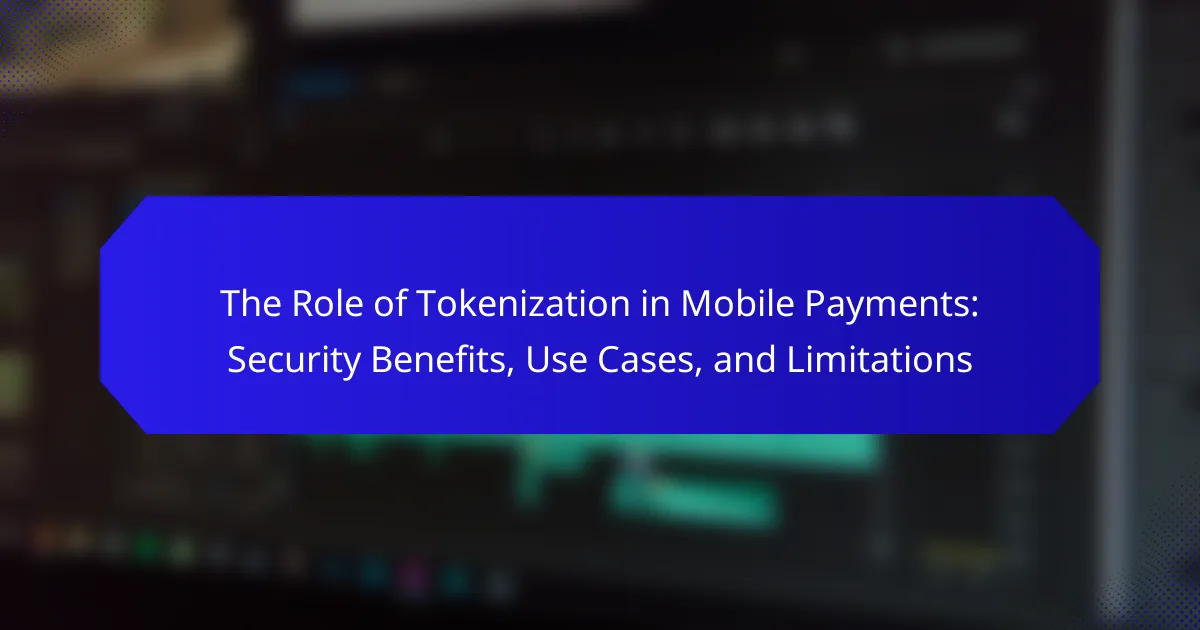Tokenization is a security process in mobile payments that replaces sensitive payment information with unique identifiers, or tokens, to protect users’ card details during transactions. This method significantly reduces the risk of data breaches by ensuring that intercepted transaction data remains useless to fraudsters. The article explores the security benefits of tokenization, including its application in in-app purchases and contactless payments, while also addressing limitations such as reliance on secure infrastructure, compatibility issues with existing payment systems, and regulatory compliance challenges. By highlighting both the advantages and drawbacks of tokenization, the article provides a comprehensive overview of its role in enhancing mobile payment security.

What is Tokenization in Mobile Payments?
Tokenization in mobile payments is a security process that replaces sensitive payment information with a unique identifier or token. This token can be used for transactions without exposing the actual card details. For example, during a mobile payment, the user’s credit card number is replaced by a token generated by the payment processor. This ensures that even if the transaction data is intercepted, it remains useless to fraudsters. Tokenization significantly reduces the risk of data breaches. According to a report by the PCI Security Standards Council, tokenization is a best practice for securing payment data.
How does tokenization enhance security in mobile payments?
Tokenization enhances security in mobile payments by replacing sensitive card information with unique identifiers called tokens. These tokens are generated randomly and have no intrinsic value, making them useless if intercepted. When a payment is processed, the actual card details are not transmitted. Instead, the token is used, which protects the user’s financial data. This reduces the risk of data breaches and fraud. According to a report by the PCI Security Standards Council, tokenization can significantly lower the chances of cardholder data being compromised. Additionally, tokens can be restricted to specific merchants or transactions, adding another layer of security.
What are the key components of a tokenization system?
A tokenization system comprises several key components. These include a tokenization engine, which generates and manages tokens. The token vault securely stores the relationship between tokens and sensitive data. An API facilitates communication between the tokenization system and other applications. Security protocols ensure data protection during token generation and transmission. A user interface allows for easy management and monitoring of the tokenization process. Together, these components work to enhance data security in mobile payments.
How do tokens replace sensitive information in transactions?
Tokens replace sensitive information in transactions by substituting it with a unique identifier. This identifier, or token, has no intrinsic value and cannot be reverse-engineered to reveal the original data. During a transaction, the token is transmitted instead of the actual sensitive information, such as credit card numbers. This process significantly reduces the risk of data breaches. According to a study by the PCI Security Standards Council, tokenization can reduce the scope of compliance requirements for organizations. Additionally, tokens can be limited to specific transactions or merchants, enhancing security further. This method effectively protects sensitive data while allowing transactions to proceed seamlessly.
Why is tokenization important for mobile payment systems?
Tokenization is important for mobile payment systems because it enhances security by replacing sensitive information with unique identifiers. This process minimizes the risk of data breaches. For instance, credit card numbers are replaced with tokens that cannot be traced back to the original data. According to the 2021 Verizon Data Breach Investigations Report, 85% of data breaches involve a human element, highlighting the need for stronger security measures. By using tokenization, mobile payment systems protect users’ financial information during transactions. This approach also fosters consumer trust, as users feel safer using mobile payments. Overall, tokenization is a critical component in safeguarding mobile payment systems against fraud and cyber threats.
What risks does tokenization mitigate in mobile transactions?
Tokenization mitigates several risks in mobile transactions, primarily data breaches and fraud. By replacing sensitive data with unique tokens, it reduces the exposure of card information. This means that even if intercepted, the tokens cannot be used for unauthorized transactions. Additionally, tokenization helps in minimizing the risk of identity theft. It ensures that personal information is not stored on devices or servers, limiting access for potential hackers. According to a study by the PCI Security Standards Council, tokenization can significantly decrease the scope of compliance requirements for businesses. This demonstrates its effectiveness in enhancing security and protecting consumer data.
How does tokenization comply with industry regulations?
Tokenization complies with industry regulations by replacing sensitive data with non-sensitive equivalents. This process minimizes the risk of data breaches. Regulations such as PCI DSS (Payment Card Industry Data Security Standard) require that sensitive information is protected. Tokenization helps businesses meet these security standards. By using tokens instead of actual card details, companies reduce their liability. Additionally, tokenization supports compliance with data protection laws like GDPR. It ensures that personal data is not stored in its original form. This approach enhances overall consumer trust in mobile payment systems.

What are the security benefits of tokenization in mobile payments?
Tokenization enhances security in mobile payments by replacing sensitive data with unique identifiers called tokens. These tokens are meaningless outside the specific transaction context. This process minimizes the risk of data breaches. Even if a hacker intercepts the token, they cannot access the original payment information. According to a study by the PCI Security Standards Council, tokenization can significantly reduce compliance scope and risks. It also limits exposure of card details during transactions. Additionally, tokenization supports encryption, further safeguarding data during transmission. This layered security approach builds consumer trust in mobile payment systems.
How does tokenization protect consumer data?
Tokenization protects consumer data by replacing sensitive information with unique identifiers called tokens. These tokens have no intrinsic value and cannot be used outside the specific transaction context. This means that even if a token is intercepted, it cannot be converted back to the original data without the appropriate decryption keys. For example, in mobile payments, when a consumer enters their credit card information, tokenization generates a token that represents this data. The actual credit card details are stored securely in a token vault, reducing the risk of data breaches. According to a study by the Payment Card Industry Security Standards Council, tokenization can reduce the scope of compliance requirements, thereby enhancing data security for businesses and consumers alike.
What role do encryption and tokenization play together?
Encryption and tokenization work together to enhance data security. Encryption transforms data into a coded format that is unreadable without a decryption key. This secures sensitive information during transmission and storage. Tokenization replaces sensitive data with unique identifiers, or tokens, that have no intrinsic value. This minimizes the risk of data breaches by limiting exposure of actual data. Together, they create a multi-layered security approach. For example, in mobile payments, encryption protects transaction data while tokenization ensures that actual card numbers are not stored or transmitted. This dual strategy significantly reduces the likelihood of fraud and data theft.
How does tokenization reduce fraud in mobile payments?
Tokenization reduces fraud in mobile payments by replacing sensitive card information with unique identifiers called tokens. These tokens are generated for each transaction and do not contain any personal data. This means that even if a token is intercepted, it cannot be used for unauthorized transactions. Additionally, tokens can only be used for a specific merchant or transaction, further limiting their usability. According to a study by the PCI Security Standards Council, tokenization can significantly decrease the risk of data breaches and fraud in payment systems. By minimizing the exposure of card details, tokenization enhances security and builds consumer trust in mobile payment methods.
What are the implications of tokenization for businesses?
Tokenization significantly enhances security for businesses by replacing sensitive payment information with unique identifiers. This process reduces the risk of data breaches. When tokenization is employed, actual card numbers are not stored or transmitted. Instead, tokens are used, making it harder for cybercriminals to access card details. Additionally, tokenization can improve customer trust. Businesses that prioritize security often attract more customers. According to a 2020 report by the PCI Security Standards Council, tokenization can reduce the scope of PCI compliance. This can lead to lower compliance costs for businesses. Overall, tokenization provides a robust security framework that benefits both businesses and customers.
How can businesses implement tokenization effectively?
Businesses can implement tokenization effectively by integrating it into their payment processing systems. They should first assess their current payment infrastructure to identify areas where tokenization can enhance security. Next, businesses must select a reliable tokenization provider that complies with industry standards such as PCI DSS.
After choosing a provider, they should ensure the seamless integration of tokenization into their existing systems. This includes training staff on the new processes and educating customers about the benefits of tokenization. Regularly updating security protocols is essential to maintain the effectiveness of tokenization.
Research shows that businesses adopting tokenization see a significant reduction in fraud, with some reports indicating a decrease of up to 50% in fraudulent transactions. By implementing these steps, businesses can leverage tokenization to secure sensitive payment information effectively.
What are the cost implications of adopting tokenization?
Adopting tokenization can lead to significant cost implications. Initial implementation costs may be high due to technology upgrades and integration. Organizations often need to invest in secure infrastructure and software solutions. Ongoing operational costs may include system maintenance and updates. However, tokenization can reduce fraud-related losses, which can offset initial expenses. According to a report by the Ponemon Institute, companies that implement tokenization can save an average of 30% on data breach costs. Overall, while initial costs are substantial, long-term savings can be realized through enhanced security and reduced fraud risk.

What are the use cases of tokenization in mobile payments?
Tokenization in mobile payments primarily enhances security by replacing sensitive card information with unique tokens. These tokens are used for transaction processing without exposing actual card details. One use case is in in-app purchases, where tokens secure user data during transactions. Another use case is contactless payments, where tokens facilitate quick and safe transactions at point-of-sale terminals. Additionally, tokenization supports recurring billing by securely storing payment details without compromising security. According to a report by the PCI Security Standards Council, tokenization reduces the risk of data breaches significantly. This makes it a preferred method for businesses handling sensitive payment information.
In which industries is tokenization most commonly used?
Tokenization is most commonly used in the financial services, healthcare, and retail industries. In financial services, it protects sensitive payment information by replacing it with unique identifiers. This reduces the risk of fraud during transactions. In healthcare, tokenization secures patient data, ensuring compliance with regulations like HIPAA. Retailers utilize tokenization to safeguard customer payment details during online and in-store purchases. These industries leverage tokenization to enhance security and build consumer trust in digital transactions.
What examples illustrate successful tokenization in retail?
Starbucks successfully uses tokenization to enhance customer loyalty. Their mobile app generates unique tokens for each transaction. This protects customer payment information while allowing easy rewards tracking.
Walmart employs tokenization for secure online transactions. Their system replaces sensitive card data with tokens during purchases. This minimizes fraud risk and maintains customer trust.
Target has implemented tokenization to safeguard customer data. They tokenize payment information at checkout to ensure security. This approach has improved customer confidence in online shopping.
These examples show how tokenization effectively secures transactions in retail.
How is tokenization utilized in the financial services sector?
Tokenization is utilized in the financial services sector to enhance security and protect sensitive data. It replaces sensitive information, such as credit card numbers, with unique identifiers called tokens. These tokens have no exploitable value outside the specific transaction context. This process reduces the risk of data breaches by ensuring that actual payment information is not stored or transmitted during transactions. According to a report by the PCI Security Standards Council, tokenization can significantly diminish the scope of compliance requirements for businesses. Additionally, tokenization supports secure mobile payments by enabling contactless transactions while safeguarding user information. As a result, it fosters consumer trust and encourages the adoption of digital payment solutions.
What are the emerging trends in tokenization for mobile payments?
Emerging trends in tokenization for mobile payments include the adoption of blockchain technology and increased regulatory compliance. Blockchain enhances security and transparency in transactions. It allows for decentralized verification, reducing fraud risks. Another trend is the integration of artificial intelligence for fraud detection. AI algorithms analyze transaction patterns in real-time. This helps in identifying anomalies and preventing unauthorized access. Additionally, mobile wallets are increasingly utilizing biometric authentication. Fingerprint and [censured] recognition add layers of security. These trends reflect a growing emphasis on user privacy and data protection. According to a report by MarketsandMarkets, the mobile payment market is expected to reach $12.06 trillion by 2027, indicating significant growth in tokenization practices.
How is the rise of digital wallets influencing tokenization?
The rise of digital wallets is significantly influencing tokenization by increasing the demand for secure transaction methods. Digital wallets store payment information securely, which enhances the need for tokenization to protect sensitive data. Tokenization replaces sensitive data with unique identifiers, or tokens, making transactions safer. As more consumers adopt digital wallets, businesses are prompted to implement tokenization to safeguard customer information. This trend is supported by the growth of mobile payment transactions, which reached $1.1 trillion in 2021, highlighting the need for enhanced security measures. Furthermore, regulatory requirements for data protection are pushing organizations to adopt tokenization alongside digital wallets. Overall, the integration of digital wallets and tokenization is essential for secure mobile payment ecosystems.
What future technologies may enhance tokenization practices?
Future technologies that may enhance tokenization practices include quantum computing, artificial intelligence, and blockchain advancements. Quantum computing can significantly improve encryption methods. This technology offers faster processing capabilities, making tokenization more secure. Artificial intelligence can enhance fraud detection in tokenization systems. AI algorithms can analyze transaction patterns in real-time. Blockchain advancements can improve transparency and traceability in tokenized transactions. These technologies collectively contribute to more robust security frameworks in mobile payments.

What limitations exist in tokenization for mobile payments?
Tokenization for mobile payments has several limitations. One major limitation is the reliance on secure infrastructure. If the tokenization system is compromised, sensitive data can still be at risk. Another limitation is the compatibility with existing payment systems. Not all merchants support tokenization, leading to potential transaction failures. Additionally, tokenization can introduce latency in transaction processing. This can affect the user experience negatively. There is also a challenge in managing token lifecycles. Tokens must be regularly updated to maintain security. Furthermore, users may face difficulties in understanding how tokenization works. This can lead to a lack of trust in mobile payment solutions. Lastly, regulatory compliance can be complex. Different regions have varying laws regarding data protection and payment processing. These limitations highlight the need for ongoing improvements in tokenization technology.
What challenges do businesses face when implementing tokenization?
Businesses face several challenges when implementing tokenization. One major challenge is integrating tokenization with existing systems. Many businesses use legacy systems that may not support tokenization technology. This can lead to increased costs and complexity during implementation.
Another challenge is ensuring compliance with regulations. Businesses must navigate various data protection laws that can affect how tokenization is applied. This requires a thorough understanding of legal requirements, which can be resource-intensive.
Additionally, businesses may encounter resistance from employees. Staff may need training to understand and effectively use tokenization systems. This can slow down the implementation process and impact overall productivity.
Finally, there is the risk of vendor lock-in. Relying on a single tokenization provider can limit flexibility and increase costs over time. Businesses need to carefully evaluate their options to avoid this pitfall.
How does the complexity of tokenization systems affect adoption?
The complexity of tokenization systems negatively affects adoption. Users often find intricate systems challenging to understand. This can lead to confusion and frustration. A study by the Federal Reserve indicated that 60% of consumers prefer simple payment solutions. When systems are complex, users may hesitate to engage with them. Businesses also face hurdles in implementing complicated tokenization. Increased training and support costs can deter adoption. Ultimately, simplicity enhances user experience and boosts acceptance rates.
What are the potential vulnerabilities associated with tokenization?
Tokenization has potential vulnerabilities that can compromise security. One vulnerability is the risk of data breaches. If the tokenization system is not properly secured, attackers may gain access to sensitive data. Another vulnerability involves the possibility of token theft. If tokens are intercepted during transmission, they can be misused. Additionally, weak encryption methods can expose tokens to unauthorized access. The reliance on third-party providers also introduces risks, as their security measures may not be robust. Furthermore, if the tokenization process is flawed, it may lead to data integrity issues. These vulnerabilities highlight the importance of robust security protocols in tokenization systems.
How can businesses overcome the limitations of tokenization?
Businesses can overcome the limitations of tokenization by implementing multi-layered security measures. These measures include encryption, which protects sensitive data during transmission. Regularly updating tokenization systems enhances resilience against emerging threats. Training employees on security best practices reduces human error, a common vulnerability. Collaborating with technology partners ensures access to the latest advancements in tokenization. Additionally, conducting regular audits helps identify weaknesses in the tokenization process. According to a 2021 study by the Ponemon Institute, organizations with strong security practices experience 50% fewer security breaches. This evidence supports the effectiveness of a comprehensive security strategy that includes tokenization.
What best practices should be followed for effective tokenization?
Effective tokenization requires several best practices. First, utilize strong encryption methods to protect sensitive data. This ensures that even if data is intercepted, it remains unreadable. Second, implement a secure key management system. Proper key management is crucial for safeguarding encryption keys. Third, ensure compliance with industry standards, such as PCI DSS. Compliance helps maintain security and trust in tokenization systems. Fourth, regularly update and patch systems to address vulnerabilities. Keeping systems up-to-date reduces the risk of exploitation. Finally, conduct regular security audits and assessments. These audits help identify weaknesses and improve tokenization processes. Following these practices enhances the security and effectiveness of tokenization in mobile payments.
How can ongoing education improve the implementation of tokenization?
Ongoing education enhances the implementation of tokenization by equipping stakeholders with essential knowledge. It ensures that developers understand the latest security protocols and standards. Continuous training helps organizations adapt to evolving cyber threats. Educated teams can better assess risks associated with tokenization. Knowledgeable personnel can implement best practices effectively. This leads to improved security measures and reduced vulnerabilities. Research shows that organizations with trained staff experience fewer data breaches. Ongoing education fosters a culture of security awareness, further strengthening tokenization efforts.
Tokenization is a security process in mobile payments that replaces sensitive payment information with unique identifiers, or tokens, to enhance data protection and reduce fraud risk. This article explores the security benefits of tokenization, including its role in minimizing data breaches and compliance with industry regulations. It also examines key components of a tokenization system, use cases across various industries, and the implications for businesses. Additionally, the article addresses limitations and challenges associated with tokenization, providing best practices for effective implementation.
